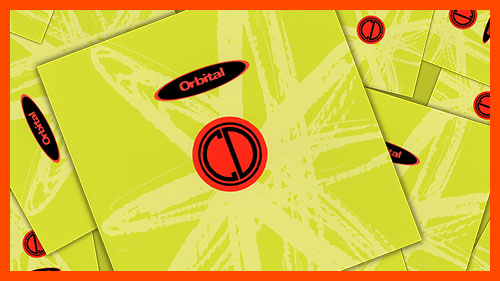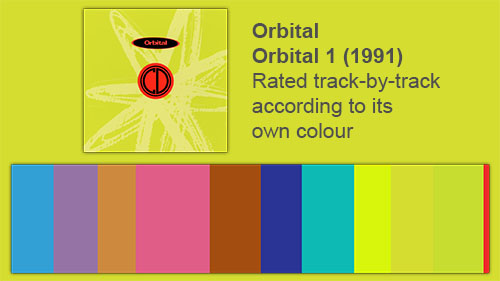Orbital's first album Orbital was called the Green Album because the cover was green. Actually, it was quite a yellow hue of green, but Quite A Yellow Hue Of Green was never going to catch on as a nickname.
The album was released in 1991 and still holds up today. That said, this diamond is a little rough. Primitive production, percussion with all the grace of a sledgehammer, loops where you can easily see the join. I caught onto the Green Album a couple of years after its release, and even then I remember it sounding dated. In a charming way.
Like a lime-liveried "go" light, the Green Album started something special. And not just because it had the stone-cold classics Chime and Belfast. Music production was about to advance at light speed. Along with their NME-recommended Brown Album two years later, the Green Album launched Orbital's transformation into stadium-filling techno gods, changing the face of techno album production.
Okay. Serious talk over. Because I have to reduce things to lists or binary choices, it leads me to the question. Just what IS the best track on Orbital's Green Album? Let's have a bit of fun and rate each track according to how close it is on the colour wheel to its own cover colour, Quite A Yellow Hue Of Green. We'll be using the UK track listing.
1. The Moebius
We start off pretty strongly. This is a solid blue. Not bland Tory blue: it's Star Trek science officer blue thanks to its sample of a Next Generation episode. It's a metallic delight, all clanks and whirring machinery, part of that taken from the opening percussion in Mad World by Tears For Fears. Extra kudos for the mobius introducing a circular theme that would repeat during the band's career.
2. Speed Freak
Speed Freak feels pretty far from yellowy green. I love the bassy bouncy orchestral stabs, and the splashy snares would return on The Brown Album. But the yelps and exclamatory interventions sound a little try-hard. The parpy theme that drops midway through is... okay. Speed Freak is a throbbing purple. No. Wait. There's the whole acid bit later on. It's a tastefully muted purple, almost fruity.
3. Oolaa
Oh crumbs. The great thing about Oola, apart from its intensity, is the rising acidic line that feels like a precursor to the ecstatic brass on Impact (The Earth Is Burning). Amid the enthusiastic synth washes in the tracks closing cacophony is a discordance that has always slightly bothered me. Therefore, this is not yellowy green. It is orange. A pleasing orange that would look good on a racing car or a cat.
4. Desert Storm
Desert Storm is the slow one. It writhes, it snakes, it plods along in a dubby way that isn't entirely unlike (a) the loping gait of the titular beasts in the 1970 film it samples, Beneath the Planet of the Apes, and (b) an Andrew Weatherall production. It feels less like an Orbital track than the rest of the album. The fact this was track-listed instead of Satan or Choice means this is pink. Not just pink. A blushing pink.
5. Fahrenheit 303
This track is somewhere between a burnt orange and a deep brown. Crumbs. There's not a lot of yellowy-green in this part of the album, is there. The jazzy keyboard riffs and knowing guiro scrapes are pure Jools Holland. Or Adamski on a bad day. Somewhere inbetween. The squiggly acid completely saves the day, as does the moody bass that closes out the track.
6. Steel Cube Idolatry
Dave Angel did a cracking Mutations mix of this track. But we're not talking about that. Cube is clanky and clumsy in a really good way. The unsettling vowel utterations sound like a diva trying to escape from a drain. Ace. It all feels adjacent to found sound, which makes me fond of the whole thing. This is not far from green. A blue. A dark block blue, so not something you'd decorate your bathroom with.
7. High Rise
Now we're talking. This is another blue, but it's more than that. It's bluey-green. High Rise is often overlooked, but it's one of the few tracks on the Green Album that stops me in my tracks. It's Belfast-soft yet Steel Cube-hard. Nicely underplayed acid blurps, tickly synth scales, loops ratcheted into hypnotic repetition, and those rolling snares. PLUS a random key change. This is all the Orbital I need.
8. Chime (Live)
Although not the single version, this is their crossover hit. It got them onto Top of the Pops in 1990 and it's still in their live set today. Does it hold up? Of course it does. The electronic take on church bells. The suspended chord line. The flanging. The stuttering percussion. The cool-ass acid. Even the hand claps. Almost the yellowy-green of the album cover. Banana yellow. Lemon yellow. Very yellow.
9. Midnight (Live)
Yellowy-green! We're at yellowy-green! Even though Belfast is still to come, Midnight is the staggering highlight of Orbital's first album. Such omen. So potent. The minor chords and staccato hi-hats set a moody scene before we're plunged into a swirling, exotic world of deep, deep techno, all beautifully structured. Even the playful low-pass knob twiddling is great. A song I can play again and again.
10. Belfast
There's not a lot to say about Belfast that hasn't already been said. It's beautiful and balaeric and most definitely a light shade of green. If Midnight is yellow-tinted, this is perhaps lime. Pretty dang close. Its clubby beach vibes and choral sampling are hugely hooked into the zeitgeist of the time: think Future Sound of London, Energy 52, The Beloved, Rhythim Is Rhythim, even Enigma.
11. "I Think It's Disgusting" (Outro)
This is just a run-off track, so not worth rating despite this loopy coda idea being emulated in many smokers' beats albums later in the decade. Okay. It's red. This is a red track. And a lovely red it is too.
So there you have it. Orbital's first album rendered into colours with the quality of content rendered as proximity to the album's cover art. Bet you never expected to be reading something like that today, did you.
In summary:



No comments:
Post a Comment
Com(m)e(nt) To Daddy...